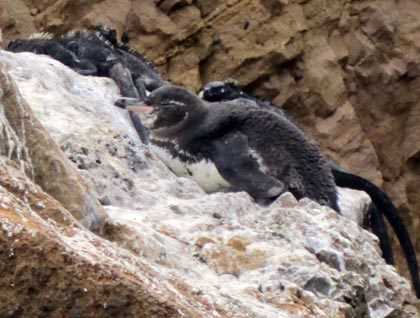After a long trip from Rabida Island, we finally arrived to the youngest part of the archipelago, where we observed the gigantic volcanoes that emerged from the ocean a long time ago. Named in honor of the Queen and King of Spain, Fernandina and Isabela Islands are home of six of the most active volcanoes in the world, the last eruption being just few weeks ago, at Wolf volcano.
Early in the morning, our guests had the opportunity to observe the marine life and the gigantic volcanoes. The sea was very calm and many marine birds, such as storm petrels, shearwaters and blue footed boobies, were engaged in a feeding frenzy, trying to catch some fish.
After breakfast, we headed to Fernandina Island. It was cloudy, windy and wavy, and near the shore we observed flightless cormorants, sea lions and sea turtles swimming indifferently among on the rocks. In contrast, the petrified marine iguanas still remained together, warming each other with their bodies due to the lack of sun. The volcano stood tall in the background, looking gigantic with its solidified black lava flows, mute evidence of recent eruptions. Walking along the white beaches, we observed several baby Galapagos sea lions and on the rocks, flightless cormorants enchanted our guests with their elaborate courtship dance. We were very fortunate, because we even observed a couple mating. Just before the end of the visit, our guests observed a Galapagos snake—it was close to us, unperturbed and moving slowly among the rocks. What an experience! But the attractions didn’t end there. Walking back to the small dock to return to the National Geographic Endeavour, we observed the spray produce by a whale that swam along Bolivar channel.
In the afternoon, we dropped anchor in Punta Vicente Roca at Isabela Island, just beside the Ecuador volcano. It looked impressive with big waves breaking along the rocks, and clouds encircling on the top. We started the activities with a snorkeling excursion along the shore, where we observed sea lions, sea turtles and flightless cormorants trying to catch some fish. Afterwards, we came back to explore the coastline from the Zodiacs, where we found a Galapagos penguin, fur seals on the rocks, and many green sea turtles showing their heads, as if calling to us for attention. With the last beams of sun, the National Geographic Endeavour moved north, crossing the equator. In a special ceremony, we shared great moments with our guests “crossing the line” and enjoying a beautiful sunset that signaled to us that the day was over, but we are left with the best memories of this incredible day, among the youngest part of Galapagos.







